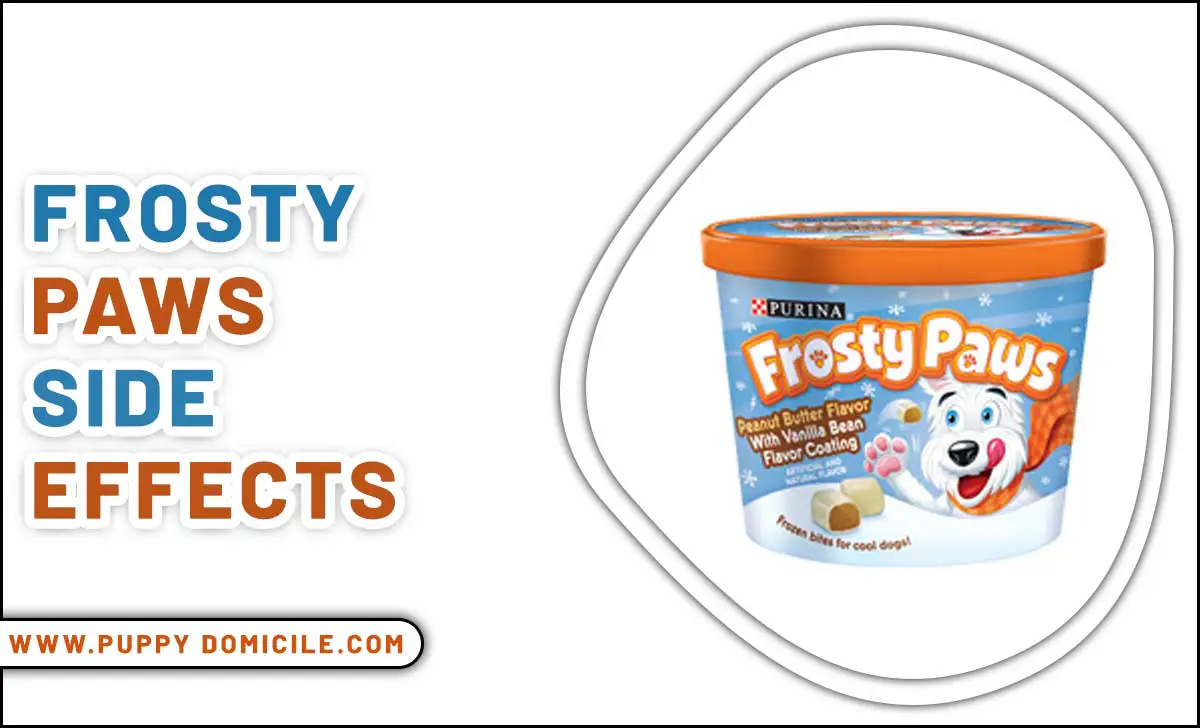As pet owners, we want to ensure our furry friends are healthy and happy. We often go the extra mile to ensure they receive the best care, including selecting the right food and snacks. One popular frozen treat for dogs is Frosty Paws.
Frosty Paws is a brand of frozen dog treats designed to provide a refreshing and tasty dog snack. These treats are made with dog-safe ingredients and are formulated to be a healthier alternative to regular ice cream, which can contain harmful ingredients like chocolate or excessive sugar.
Frosty Paws typically come in small cups, making them easy to serve. They are available in various flavours, such as original and peanut butter, and can be found in the frozen food section of many grocery stores.
We will examine Frosty Paws, including its ingredients and nutritional value. While Frosty Paws may seem like a harmless and enjoyable snack for your furry friend, it’s essential to understand the potential risks associated with feeding it to your dog. As pet owners, we are responsible for educating ourselves about the food products we give our pets. Let’s get to know the details about Frosty Paws’ side effects.

Potential Side Effects Of Frosty Paws For Your Dog

Frosty Paws is a popular dog treat brand known for its frozen dog treats. Many dog owners may not be aware of the potential side effects that Frosty Paws, a popular frozen treat for dogs, can have on their furry friends.
While it may seem harmless and tasty, Frosty Paws contains several ingredients that can harm dogs if consumed in large quantities. While generally considered safe for dogs, there are potential side effects to be aware of:
1.Digestive Issues

Frosty Paws, a popular frozen dog treat, can cause digestive issues in some dogs. These may include diarrhea, vomiting, and stomach discomfort due to ingredients like dairy or artificial additives. Dogs with sensitive stomachs or food intolerances are particularly susceptible.
To minimize risk, introduce Frosty Paws gradually and monitor your pet for any adverse reactions. If digestive problems persist, discontinue use and consult your veterinarian for alternative treatment options that are gentler on your dog’s digestive system.
2.Allergic Reactions

To prevent allergic reactions, introduce new treats slowly and monitor your pet’s reaction closely. If you suspect your dog may have a food allergy or sensitivity, talk to your veterinarian about alternative treatment options that may suit their needs.
3.Obesity And Weight Gain

Feeding your dog Frosty Paws regularly can contribute to obesity and weight gain. These treats are often high in calories and sugar, which, if given in excess, can lead to your dog consuming more calories than they burn. Over time, this can result in weight gain and associated health issues like joint problems, diabetes, and heart disease.
To maintain your dog’s health, monitoring their treatment intake and ensuring a balanced diet and regular exercise is crucial. Instead of relying on high-calorie treats like Frosty Paws, consider low-calorie alternatives such as frozen fruits or vegetables to keep your furry friend healthy and happy. Always consult your veterinarian before introducing any new food or treat into your dog’s diet.
4.Pancreatitis
Suppose you suspect your dog might be prone to pancreatitis issues. In that case, it’s crucial to consult with your veterinarian before introducing Frosty Paws or any new treat into their diet. Frosty Paws, a popular brand of cream for dogs, may cause stomach upset in some pets.
Potential Reasons For These Side Effects In Dogs

Here are some potential reasons for these side effects in dogs:
- Preservation error
- Habitual error
- Overconsumption
- Inappropriate intake
- Toxic ingredients
- Nutritional imbalance
- Contamination
- Psychological factors
Ingredients In Frosty Paws That May Cause Side Effects

Frosty Paws dog treats contain various ingredients that can potentially cause side effects in your furry friend. The high sugar content in Frosty Paws can lead to obesity and diabetes, while dairy products may trigger allergies and digestive issues. Additionally, artificial sweeteners, colors, and flavors can cause adverse reactions in dogs.
Artificial Sweeteners
Artificial sweeteners like xylitol, sorbitol, and maltodextrin are commonly used to sweeten Frosty Paws. However, these sweeteners, especially xylitol, can be dangerous for dogs. Xylitol can cause a rapid insulin release in dogs, leading to hypoglycemia and liver damage.
Sorbitol and maltodextrin may cause digestive issues in some dogs, such as bloating and diarrhea. To avoid any potential side effects, it’s important to always read the ingredients label before feeding your dog any human food or treats.
Artificial Colors And Flavors
Artificial colors and flavors may be a red flag regarding frozen dog treats. Frosty Paws contains these additives that can cause gastrointestinal upset in some dogs. While not all dogs will have adverse reactions, choosing natural ingredients over artificial ones may help prevent unwanted side effects.
It’s also essential to read the ingredient list carefully before feeding your dog any food or treat and opt for whole food options whenever possible. Your dog’s digestive system will thank you. High-quality protein is essential for maintaining muscle mass and promoting overall health.
When To Avoid Giving Your Dog Frosty Paws

While Frosty Paws may seem like a tasty treat for your furry friend, there are certain situations where you should avoid giving it to them. For example, suppose your dog has a history of digestive issues or food sensitivities.
In that case, Frosty Paws may not be the best choice if your dog is overweight or on a restricted diet. You should check with their veterinarian before giving them new treats or snacks. It is important always to read ingredient labels and consult with a professional if you have any concerns about what to feed your dog by being mindful of your dog’s specific needs and dietary restrictions.
Alternatives To Frosty Paws
When treating your furry friend, there are plenty of alternatives to Frosty Paws. Here are some alternatives to frosty paws:
- Homemade frozen treats using ingredients like yogurt, peanut butter, and banana
- Frozen fruit chunks such as watermelon, blueberries, or strawberries
- Pumpkin puree frozen in ice cube trays
- Dogsafe ice cream brands like Puppy Scoops or Dogsters
- Frozen broth cubes made from low-sodium chicken or beef broth
Conclusion
Frosty Paws may seem like a delicious and refreshing treat for your furry friend, but it’s important to be aware of the potential side effects that come with it. From digestive issues to obesity and weight gain, the risks outweigh the benefits.
Instead, consider homemade frozen dog treats or store-bought dog ice creams and frozen treats made with natural ingredients that will not harm your pet.
Always consult your veterinarian before introducing any new food or treat into your dog’s diet. Your dog’s health is in your hands, so make informed choices prioritizing their well-being. Frosty Paws’ side effects are important to consider when evaluating the health benefits of this treat for dogs.
Frequently Asked Questions
1.What Are Frosty Paws Made Of?
Frosty Paws is a frozen treat for dogs that is typically made with ingredients such as water, whey, soy flour, liver powder, and various vitamins and minerals. These ingredients are blended and frozen into individual servings for dogs to enjoy as a cool and refreshing treat.
2.How Much Sugar Is In Frosty Paws?
Frosty Paws contain approximately 1.5 grams of sugar per serving. While this may seem like a small amount, it is important to understand the potential impact of sugar on our furry friends.
3.Is Frost Ok For Dogs?
Frostbite and hypothermia are common risks for dogs exposed to extreme cold, so it is important to limit their time outside in frosty conditions and provide them with adequate shelter, warmth, and protection.
4.Are Frosty Paws Dairy?
No, Frosty Paws are not dairy-based. They are frozen treats designed specifically for dogs and are typically made with ingredients such as water, vegetable oil, whey, and other dog-friendly components. These frozen treats are formulated to be safe and enjoyable for dogs to consume, providing a refreshing snack without dairy ingredients that could potentially upset their stomachs.
5.Are Frosty Paws Vegan?
No, Frosty Paws are not vegan as they contain dairy products like milk and whey. While they may seem like a harmless and delicious snack for our furry friends, some pet owners may wonder if Frosty Paws suit dogs following a vegan diet.
6.What Happens If Your Dog Eats Chocolate Ice Cream?
If a dog eats chocolate ice cream, they may experience symptoms such as vomiting, diarrhea, increased heart rate, restlessness, and even seizures due to the toxicity of chocolate to dogs. It is important to seek immediate veterinary care if your dog ingests chocolate ice cream to prevent serious health complications.
7.Is Frosty Paws Ice Cream Safe For Humans?
They specifically formulate Frosty Paws ice cream for dogs. It may not be safe for humans due to ingredients not intended for human consumption, such as milk and sugar substitutes that can cause digestive issues. Sticking to ice cream made for human consumption is best to avoid potential health risks.
8.Can Eating Too Much Ice Cream Cause Diarrhea?
Feeding your dog too much ice cream, especially puppy ice cream, can lead to diarrhea due to lactose intolerance. Dogs lack sufficient lactase to digest dairy properly, causing gastrointestinal upset. Moreover, the high sugar content in ice cream can disrupt a dog’s diet, potentially affecting their skin health. Treats like cookies or special dog-friendly ice creams should be given in moderation to prevent digestive issues.
9.What Happens If Your Dog Eats Chocolate Ice Cream?
If a dog consumes chocolate ice cream, it can lead to chocolate toxicity due to the presence of theobromine, a compound toxic to dogs. Symptoms may include vomiting, diarrhea, rapid breathing, increased heart rate, and in severe cases, seizures or death. It’s crucial to seek immediate veterinary assistance if a dog ingests chocolate ice cream to prevent complications.
10.Can Your Dog Eat Other Flavors Of Ice Cream?
While some flavors of ice cream may be safe for dogs in moderation, it’s essential to avoid ingredients like chocolate, xylitol, and excessive sugar. Opt for dog-friendly flavors such as plain vanilla or peanut butter, and always check for harmful additives. It’s best to consult with a veterinarian before offering any new treat to ensure it’s safe for your dog’s health.
